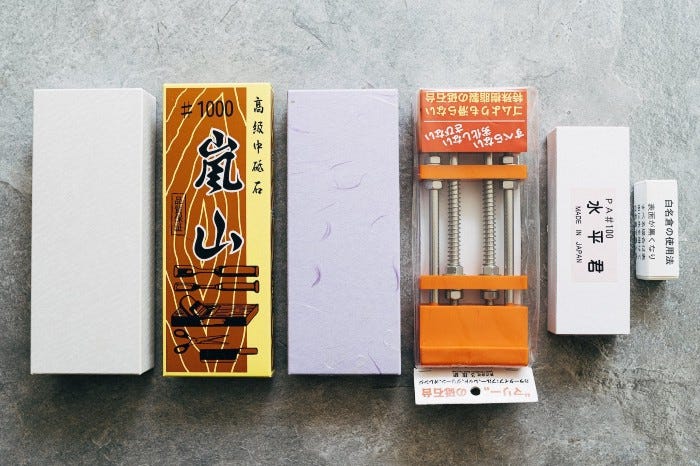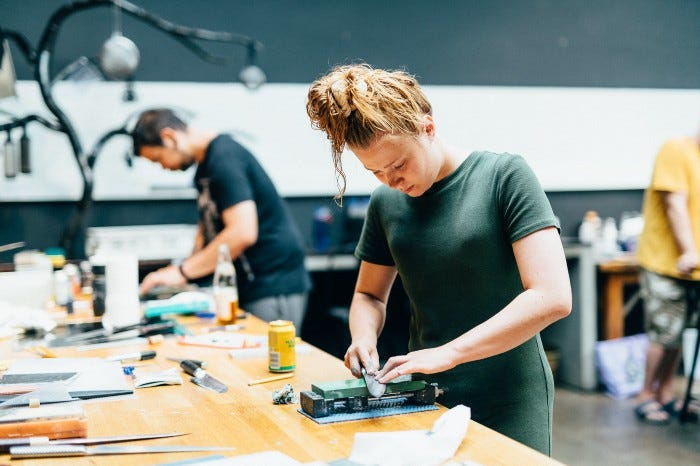Sharpening Japanese knives - this is how you succeed
You are in a situation where you realize that your kitchen knives are dull and you want to start sharpening them. You can quickly familiarize yourself with the matter with the help of YouTube, for example, but you should know how to distinguish the good from the bad from a huge number of instructions. There are so many sharpening tools and instructions for using them that a moderately sized work group would be needed to go through all the data.
How to start knife sharpening
Someone recommends diamond stones, another one oil stones, and a third is of the opinion that the only way to achieve an authentic result is to use Japanese natural stones.
Sharpening a Japanese kitchen knife doesn't have to be complicated, at least not with the accessories. Less is more.
The basics of sharpening, as I have learned them myself
I personally prefer water grinding stones. They are more pleasant to use in kitchen conditions than oilstones, which are more suitable for offices or workshops. Natural stones, on the other hand, are interesting, but very expensive, and delving into them is an endlessly deep rabbit hole for a sharpener, which is not delved into in this text.
My method is by no means the only correct one, but I believe that I can give precise instructions to a beginner sharpener from some of my experience.
An example of cutting an onion with a sharp knife.
What do you need?
Sharpening stones for sharpening Japanese knives clearly require at least one. Preferably two, optimally three:
- Medium coarse (approx. 800–2000 grit#)
- Fine (approx. 3000-6000 grit#)
- Coarse (approx. 120–400 grit#)
As a general rule, the roughness of the stones can therefore be divided into three categories: medium, fine and coarse. You can also get the stones in this order.
How do you start?
A slightly dull knife is sharpened quickly with a light sharpening of 1000 grit# (e.g. Arashiyama 1000 ) with a stone of coarseness. A medium-coarse stone makes it easy to practice, while a coarse stone, which removes metal quickly, can get things done too quickly. Often, at the same time as the medium-coarse stone, a fine stone is acquired for finishing the sharpening, i.e. honing (e.g. Tamago 4000 grit ). After the first contact with sharpening and related techniques, it's time to move on to the rough stone. This works well in terms of timing, because after the technique has been learned for a while with finer stones, it is easy to thin and sharpen knives quickly and efficiently with a coarse stone. When the size sharpening set purchased in one go, it is often a bit cheaper.
What is the difference between different brands of stones?
When choosing sharpening stones, it is better to prefer well-known stone manufacturers (e.g. Imanishi, Shapton, Naniwa) than composite stones offered by mass-produced knife brands. Of course, there are positive exceptions in them too. There are both synthetic and significantly more expensive natural stones on the market. Synthetic stones, on the other hand, are made with a variety of binders that affect the sharpening feel. Now, however, let's make it as simple as possible.

A few tips for sharpening kitchen knives
- If you sharpen mostly stainless, soft-edged, European knives (approx. HRC 54), you should stick to coarse ones (e.g. Marble 400 ) as well as in medium rough stones (e.g. Arashiyama 1000 ).
- When sharpening stainless Japanese kitchen knives, which are usually made of hard-treated steel, the blade can be finished much finer and sharper. When sharpening Japanese knives, you also benefit from a fine sharpening stone (e.g. Tamago 4000 grit ).
- Because the harder steel of a carbon steel kitchen knife can withstand a fine blade, carbon steel is also often finished with a fine stone. Carbon steel is also often more finely crystalline than high-alloy stainless steel. That's why it can be said that carbon steel, which rusts more easily, is in a way finer stuff. At least that's how many passionate purists feel. Carbon steel is at least easier to learn to sharpen than stainless steel.

Summary
So you would like to need one medium-coarse sharpening stone (approx. 1000 grit#), one fine sharpening stone (3000–6000 grit#) and a leveling stone (e.g. Leveling stone P-100 ) with which the grinding surface of the stone is kept straight. A sharpening stand is also very useful, but not essential. If sharpening interests you and you want to learn more together, KIKI Knives organizes courses that will help you start your journey towards a sharper life.
